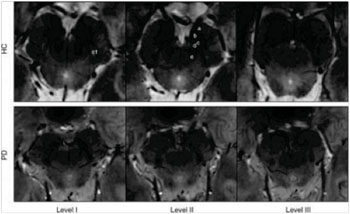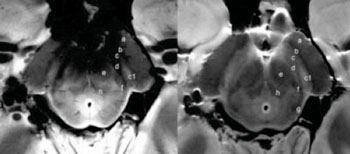Ultrahigh-Field MRI Shows Potential for Earlier Diagnosis of Parkinson’s Disease
|
By MedImaging International staff writers Posted on 20 Mar 2014 |

Top row: 7-Tesla 3D multiecho susceptibility-weighted in vivo images of SN in healthy 64-year-old man, located between the crus cerebri (a) and the red nucleus. Axial sections perpendicular to the floor of fourth ventricle are obtained at level of the inferior third of the red nucleus (level I), at the level of decussation of superior cerebellar peduncles (e) (level II), and at the level of the inferior colliculi (level III). At level I, substantia nigra (SN) appears as homogeneous hypointense structure in the medial part of the cerebral peduncle, and is laterally constituted by a hyperintense oval area between two hypointense layers (c1). At level II, a trilaminar organization of the SN with a central hyperintense layer (b) between two hypointense tiers (c and d) is detectable. At level III, the dorsal hypointense lamina could be detected as a small residual lateral hypointense area, while the hyperintense layer fades into the isointense cerebral peduncle. Bottom row: 7-T three-dimensional multiecho susceptibility-weighted in vivo images of the SN in PD patients. The loss of normal anatomy of the SN in a 61-year-old man with PD is characterized by the disappearance of the oval-shape bright spot in the lateral part of the SN at level I and by the loss of the hyperintense intermediate layer of the SN at level II. HC = healthy subject (Photo courtesy of the Radiological Society of North America).

Image: axial spin-echo proton density (on the right) and GRE (on the left) of the substantia nigra (SN) at level I of an ex vivo brain sample in a 67-year-old woman. There is a triple-layered organization of the SN comparable to that showed in the in vivo images. Ventrally a low-signal-intensity layer (b) is attributable to the pars reticulata of the SN. In the middle part of the SN, a hyperintense band (c) corresponds to the ventral component of the pars compacta of the SN. The lateral part of this layer shows a high-signal intensity spot (c1) corresponding to the oval shape hyperintensity of the in vivo 3D multiecho susceptibility-weighted images that resemble the nigrosome formation. The dorsal hypointense layer visible on both spin-echo and GRE images (d) is referred to the dorsal component of the pars compacta of the SN. a = crus cerebri, e = brachjum conjunctivum, f = medial lemniscus, g = lateral lemniscus, h = central tegmental tract (Photo courtesy of the Radiological Society of North America).
New research has revealed that ultrahigh-field magnetic resonance imaging (MRI) provides detailed views of a brain area implicated in Parkinson’s disease (PD); possibly leading to earlier detection of a disorder that affects millions worldwide.
The study’s findings are published online March 2014 in the journal Radiology. Parkinson’s disease is a chronic, progressive disease characterized by stiffness, shaking, and impaired balance and coordination. With no imaging modalities available to help in diagnosis, clinicians have had to depend on medical history and neurologic exam. It is frequently problematic to distinguish PD from other disorders using these techniques alone.
Mirco Cosottini, MD, from the University of Pisa (Italy), and colleagues examined the brains of 38 individuals, including 17 PD patients and 21 healthy control subjects, as well as a brain sample from a deceased individual, to help determine the effectiveness of ultra-high-field 7-Tesla MRI for identifying PD.
The investigators, utilizing the 7-Tesla MRI scanning, were able to differentiate a three-layered organization of the substantia nigra (SN), a crescent-shaped mass of cells in the midbrain. PD results from the loss of dopamine-producing cells located in this region of the brain. Dopamine is an important neurotransmitter involved in a number of brain functions, including motor and behavioral processes such as addiction, mood, reward, and stress.
Based on abnormalities in the SN identified by the 7-Tesla MRI scanning, the researchers accurately categorized patients with PD with a sensitivity of 100% and specificity of 96.2%.
According to Dr. Cosottini, the findings show potential for earlier detection of the disease, which could speed the initiation of treatment. “Parkinson’s disease diagnosis remains clinically based, but with the introduction of 7-Tesla MRI into clinical practice, a supporting radiologic diagnosis can be made,” he said.
The researchers also are investigating the clinical usefulness of 7-Tesla MRI in several other neurodegenerative disorders, including mild cognitive impairment, a precursor of Alzheimer’s disease.
Related Links:
University of Pisa
The study’s findings are published online March 2014 in the journal Radiology. Parkinson’s disease is a chronic, progressive disease characterized by stiffness, shaking, and impaired balance and coordination. With no imaging modalities available to help in diagnosis, clinicians have had to depend on medical history and neurologic exam. It is frequently problematic to distinguish PD from other disorders using these techniques alone.
Mirco Cosottini, MD, from the University of Pisa (Italy), and colleagues examined the brains of 38 individuals, including 17 PD patients and 21 healthy control subjects, as well as a brain sample from a deceased individual, to help determine the effectiveness of ultra-high-field 7-Tesla MRI for identifying PD.
The investigators, utilizing the 7-Tesla MRI scanning, were able to differentiate a three-layered organization of the substantia nigra (SN), a crescent-shaped mass of cells in the midbrain. PD results from the loss of dopamine-producing cells located in this region of the brain. Dopamine is an important neurotransmitter involved in a number of brain functions, including motor and behavioral processes such as addiction, mood, reward, and stress.
Based on abnormalities in the SN identified by the 7-Tesla MRI scanning, the researchers accurately categorized patients with PD with a sensitivity of 100% and specificity of 96.2%.
According to Dr. Cosottini, the findings show potential for earlier detection of the disease, which could speed the initiation of treatment. “Parkinson’s disease diagnosis remains clinically based, but with the introduction of 7-Tesla MRI into clinical practice, a supporting radiologic diagnosis can be made,” he said.
The researchers also are investigating the clinical usefulness of 7-Tesla MRI in several other neurodegenerative disorders, including mild cognitive impairment, a precursor of Alzheimer’s disease.
Related Links:
University of Pisa
Latest MRI News
- Cutting-Edge MRI Technology to Revolutionize Diagnosis of Common Heart Problem
- New MRI Technique Reveals True Heart Age to Prevent Attacks and Strokes
- AI Tool Predicts Relapse of Pediatric Brain Cancer from Brain MRI Scans
- AI Tool Tracks Effectiveness of Multiple Sclerosis Treatments Using Brain MRI Scans
- Ultra-Powerful MRI Scans Enable Life-Changing Surgery in Treatment-Resistant Epileptic Patients
- AI-Powered MRI Technology Improves Parkinson’s Diagnoses
- Biparametric MRI Combined with AI Enhances Detection of Clinically Significant Prostate Cancer
- First-Of-Its-Kind AI-Driven Brain Imaging Platform to Better Guide Stroke Treatment Options
- New Model Improves Comparison of MRIs Taken at Different Institutions
- Groundbreaking New Scanner Sees 'Previously Undetectable' Cancer Spread
- First-Of-Its-Kind Tool Analyzes MRI Scans to Measure Brain Aging
- AI-Enhanced MRI Images Make Cancerous Breast Tissue Glow
- AI Model Automatically Segments MRI Images
- New Research Supports Routine Brain MRI Screening in Asymptomatic Late-Stage Breast Cancer Patients
- Revolutionary Portable Device Performs Rapid MRI-Based Stroke Imaging at Patient's Bedside
- AI Predicts After-Effects of Brain Tumor Surgery from MRI Scans
Channels
Radiography
view channel
AI Improves Early Detection of Interval Breast Cancers
Interval breast cancers, which occur between routine screenings, are easier to treat when detected earlier. Early detection can reduce the need for aggressive treatments and improve the chances of better outcomes.... Read more
World's Largest Class Single Crystal Diamond Radiation Detector Opens New Possibilities for Diagnostic Imaging
Diamonds possess ideal physical properties for radiation detection, such as exceptional thermal and chemical stability along with a quick response time. Made of carbon with an atomic number of six, diamonds... Read moreUltrasound
view channel.jpeg)
AI-Powered Lung Ultrasound Outperforms Human Experts in Tuberculosis Diagnosis
Despite global declines in tuberculosis (TB) rates in previous years, the incidence of TB rose by 4.6% from 2020 to 2023. Early screening and rapid diagnosis are essential elements of the World Health... Read more
AI Identifies Heart Valve Disease from Common Imaging Test
Tricuspid regurgitation is a condition where the heart's tricuspid valve does not close completely during contraction, leading to backward blood flow, which can result in heart failure. A new artificial... Read moreNuclear Medicine
view channel
Novel Radiolabeled Antibody Improves Diagnosis and Treatment of Solid Tumors
Interleukin-13 receptor α-2 (IL13Rα2) is a cell surface receptor commonly found in solid tumors such as glioblastoma, melanoma, and breast cancer. It is minimally expressed in normal tissues, making it... Read more
Novel PET Imaging Approach Offers Never-Before-Seen View of Neuroinflammation
COX-2, an enzyme that plays a key role in brain inflammation, can be significantly upregulated by inflammatory stimuli and neuroexcitation. Researchers suggest that COX-2 density in the brain could serve... Read moreGeneral/Advanced Imaging
view channel
CT-Based Deep Learning-Driven Tool to Enhance Liver Cancer Diagnosis
Medical imaging, such as computed tomography (CT) scans, plays a crucial role in oncology, offering essential data for cancer detection, treatment planning, and monitoring of response to therapies.... Read more
AI-Powered Imaging System Improves Lung Cancer Diagnosis
Given the need to detect lung cancer at earlier stages, there is an increasing need for a definitive diagnostic pathway for patients with suspicious pulmonary nodules. However, obtaining tissue samples... Read moreImaging IT
view channel
New Google Cloud Medical Imaging Suite Makes Imaging Healthcare Data More Accessible
Medical imaging is a critical tool used to diagnose patients, and there are billions of medical images scanned globally each year. Imaging data accounts for about 90% of all healthcare data1 and, until... Read more
Global AI in Medical Diagnostics Market to Be Driven by Demand for Image Recognition in Radiology
The global artificial intelligence (AI) in medical diagnostics market is expanding with early disease detection being one of its key applications and image recognition becoming a compelling consumer proposition... Read moreIndustry News
view channel
GE HealthCare and NVIDIA Collaboration to Reimagine Diagnostic Imaging
GE HealthCare (Chicago, IL, USA) has entered into a collaboration with NVIDIA (Santa Clara, CA, USA), expanding the existing relationship between the two companies to focus on pioneering innovation in... Read more
Patient-Specific 3D-Printed Phantoms Transform CT Imaging
New research has highlighted how anatomically precise, patient-specific 3D-printed phantoms are proving to be scalable, cost-effective, and efficient tools in the development of new CT scan algorithms... Read more
Siemens and Sectra Collaborate on Enhancing Radiology Workflows
Siemens Healthineers (Forchheim, Germany) and Sectra (Linköping, Sweden) have entered into a collaboration aimed at enhancing radiologists' diagnostic capabilities and, in turn, improving patient care... Read more





















